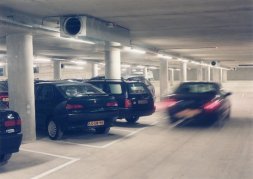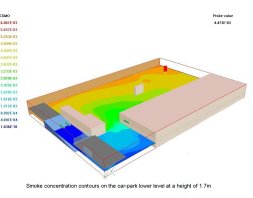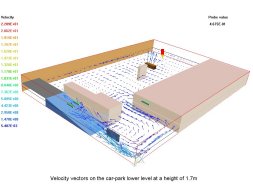-
地下停車場火災煙霧模擬
時間:2014-02-13 14:28:04 作者:本站編輯 來源:綠建之窗 閱讀:2521內容摘要:CFDisbeingusedincreasinglytocomplementtheengineeringdesignoffireandsmokeventilationsystemsrequiredtomeetfiresafetyregulations.TheuseofCFDtos...CFD is being used increasingly to complement the engineering design of fire and smoke ventilation systems required to meet fire safety regulations. The use of CFD to simulate smoke removal during fires allows design strategies for ventilation to be investigated for different scenarios before construction and installation. In particular the response of key components of the smoke control system, such as powered exhaust ventilation fans, ceiling-mounted jet fans and smoke curtains, can be examined in terms of facilitating fire fighting operations and maintaining clear escape and access routes.
fire safety regulations. The use of CFD to simulate smoke removal during fires allows design strategies for ventilation to be investigated for different scenarios before construction and installation. In particular the response of key components of the smoke control system, such as powered exhaust ventilation fans, ceiling-mounted jet fans and smoke curtains, can be examined in terms of facilitating fire fighting operations and maintaining clear escape and access routes.The CFD code PHOENICS 3.4 has been used by Rucon B.V.Ventilatoran to investigate the performance of a fire-protection system
 in the event of a car fire in an underground car park. The fire-protection system in the car park comprises a smoke-exhaust ventilation system with a number of strategically-placed jet fans that transport the air-smoke mixture towards the extraction fans. The system is intended to ensure the safe escape of the occupants from the various car-park levels by maintaining any smoke layer above the heads of the people. The PHOENICS model simulated two levels of the car park and included such details as ceiling-mounted ventilators, extract fans, columns, dividing and external walls, ramps and other internal structures. The task was to predict fire and smoke movement in the underground car park for a number of ventilation designs. PHOENICS was used to simulate a car fire on the lower level by means of a time-dependent source of heat and smoke; thermal radiation was modelled by means of the computationally efficient and pragmatic IMMERSOL model. The final design for fire containment employed jet fans on the upper level to force air down towards an extract fan located on the lower level.
in the event of a car fire in an underground car park. The fire-protection system in the car park comprises a smoke-exhaust ventilation system with a number of strategically-placed jet fans that transport the air-smoke mixture towards the extraction fans. The system is intended to ensure the safe escape of the occupants from the various car-park levels by maintaining any smoke layer above the heads of the people. The PHOENICS model simulated two levels of the car park and included such details as ceiling-mounted ventilators, extract fans, columns, dividing and external walls, ramps and other internal structures. The task was to predict fire and smoke movement in the underground car park for a number of ventilation designs. PHOENICS was used to simulate a car fire on the lower level by means of a time-dependent source of heat and smoke; thermal radiation was modelled by means of the computationally efficient and pragmatic IMMERSOL model. The final design for fire containment employed jet fans on the upper level to force air down towards an extract fan located on the lower level.The PHOENICS INFORM facility was employed to specify via the pre-processor a smoke-dependent gas emissivity. In addition INFORM was used by Rucon to introduce their own formulae for computing the volumetric smoke concentration and estimates of the local visibility. The advantage of INFORM is that it obviates the need for user FORTRAN and recompilation, and it also enables easy and flexible interpretation of the solution fields in an engineering framework.
 The PHOENICS analysis allowed optimisation and verification of Rucon's ventilation strategy. Rucon commented "We have used CFD to prove that in the case of a car fire on the lower level, smoke does not progress to the upper level by use of the right ventilation system and strategy. The reason and the big advantage we have by using PHOENICS, is the fact that we can predict the movement of air and smoke in a car park before something is installed. We can make the airflow visible and understandable."
The PHOENICS analysis allowed optimisation and verification of Rucon's ventilation strategy. Rucon commented "We have used CFD to prove that in the case of a car fire on the lower level, smoke does not progress to the upper level by use of the right ventilation system and strategy. The reason and the big advantage we have by using PHOENICS, is the fact that we can predict the movement of air and smoke in a car park before something is installed. We can make the airflow visible and understandable."
- 相關文章
-
-
08-02大型商業綠色建筑設計實踐
-
綠建軟件
本欄最新更新
-
12-28【課堂】101《綠建標準》2019第八章-評分項-8.2.8室外風環境模擬
-
12-13疫情后,如何讓建筑自然通風是設計之重!
-
11-19綠色建筑的被動式自然通風設計方法
-
09-13疫情當下,綠色建筑中的自然通風有多重要
-
08-05Phoenics-室外風環境分析和室內通風模擬軟件介紹
-
08-08推薦!綠建之窗風、熱軟件介紹
-
11-14WindPerfectdx前期操作基本流程
-
08-01STREAM 通用流體分析軟件
-
05-08Fluent 6.3 流體分析軟件
-
04-24綠建軟件 建筑通風Vent軟件簡介
本欄推薦
閱讀排行
通信地址: 北京市豐臺區汽車博物館東路1號諾德中心2期6號樓1201 郵編:100070 網站合作:QQ:1658253059 電話: 13693161205 18501126985
 京公網安備11010602007284號 京ICP備14061276號-3
51LA統計
京公網安備11010602007284號 京ICP備14061276號-3
51LA統計



